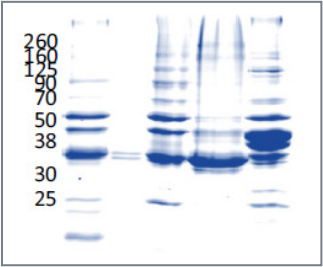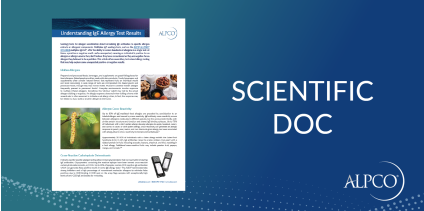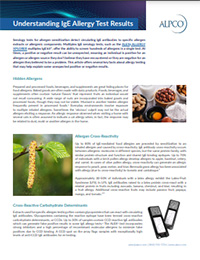Understanding IgE Allergy Test Results
Serology tests for allergen sensitization detect circulating IgE antibodies to specific allergen extracts or allergenic components. Multiplex IgE serology tests, such as the ALEX2 ALLERGY XPLORER multiplex IgE kit*, offer the ability to screen hundreds of allergens in a single test. At times, a positive or negative result can be unexpected, meaning an individual is positive for an allergen or allergen source they don’t believe they have encountered or they are negative for an allergen they believed to be a problem. This article offers several key facts about allergy testing that may help explain some unexpected positive or negative results.
Hidden Allergens
Prepared and processed foods, beverages, and supplements are great hiding places for food allergens. Baked goods are often made with dairy products. Foods, beverages, and supplements often contain ‘natural flavors’ that represent fruits an individual would not recall consuming. A wide range of nuts are incorporated into baked goods and processed foods, though they may not be visible. Mustard is another hidden allergen frequently present in processed foods.1 Everyday environments involve exposure to multiple inhaled allergens. Sometimes the ‘obvious’ culprit may not be the actual allergen eliciting a response. An allergic response observed when visiting a home with several cats is often assumed to indicate a cat allergy when, in fact, the response may be related to dust, mold or another allergen in the home.




Allergen Cross-Reactivity
Up to 80% of IgE-mediated food allergies are preceded by sensitization to an inhaled allergen and caused by cross-reactivity. IgE antibody cross-reactivity occurs between allergenic molecules in different species, but the same protein family, with similar protein structure and function and shared IgE-binding epitopes. Up to 70% of individuals with a birch pollen allergy develop allergies to apple, hazelnut, celery, and carrot. In cases of olive pollen allergy, cross-reactivity can generate an allergic response to peach, pear, melon, and kiwi. Bermuda grass allergy has been associated with allergy (due to cross-reactivity) to tomato and cantaloupe.2
Approximately 30-50% of individuals with a latex allergy exhibit the Latex-Fruit Syndrome (LFS). In LFS, IgE antibodies raised to a latex protein cross-react with a related protein in fruits including avocado, banana, chestnut, and kiwi, resulting in a fruit allergy. Additional cross-reactive fruits may include passion fruit, papaya, mango, and tomato.2,3
Cross-Reactive Carbohydrate Determinants
Extracts used for specific allergen testing often contain glycoproteins that can react with circulating IgE antibodies. Glycoproteins containing the reactive epitope have been termed cross-reactive carbohydrate determinants, or CCDs. Up to 30% of samples contain CCD-reactive IgE antibodies which can generate false positive results in some IgE allergy tests.4 The ALEX2 test incorporates strong inhibitors and a high percentage of recombinant molecular allergens to minimize false positives due to CCD binding. A CCD spot on the array flags samples with exceptionally high levels of anti-CCD IgE antibodies for re-testing.


Variability in Allergen Extracts
The lack of standardization of allergen extracts is another potential cause of unexpected allergy test results. Differing amounts of allergenic components from one manufactured extract to another or the presence of a contaminant in an extract can be a key source of variability when comparing IgE results between skin prick and serology tests or between IgE antibody tests from different manufacturers. One study analyzed twenty-six commercial fish extracts from five manufacturers. Total protein, allergen concentration and IgE reactivity varied more than 10-fold between manufacturers (Image 1.) and fish species and the major fish allergen, parvalbumin, was undetected in 6 of the 26 extracts.5 Similar discrepancies have been observed for other allergen extracts.
According to the World Allergy Organization (WHO), allergenic extracts used for diagnostics should be standardized, meaning manufacturers should quantify the presence of major allergen components in their extracts. The WHO also cautions that allergen extract potency deteriorates with time. This is another source of variability in skin prick testing.6 In the U.S. there are currently 19 standardized allergen extracts maintained by the Center for Biologics Evaluation and Research (CBER). Most allergen extracts are non-standardized.7 The high percentage of well-characterized molecular allergens (specific allergen components) in the ALEX2 panel and strict quality control testing to ensure the presence of the appropriate allergenic components in allergen extracts increases the accuracy and reproducibility of IgE testing.


Image 1. SDS-Page gel of cod extracts from 5 different manufacturers.5
Importance of Exposure in Determining Sensitization
Because circulating antibody levels dissipate over time, a positive IgE antibody test requires both allergen sensitization and recent exposure. While the rate of decline in circulating antibody levels will vary, serology tests become less effective as the time from last exposure increases. This is one reason a skin prick test may be positive while a serology test for specific IgE antibodies is negative.
Immune Tolerance
It is generally understood that a positive allergen test does not guarantee an individual will demonstrate a physical reaction to an allergen. In some cases, an individual may inherit or develop a tolerance for an allergen to which they are sensitized. This is the basis for immunotherapy treatment. Recent studies have shown that acquired allergen tolerance is linked to an increase in IgG antibodies which may out-compete IgE antibodies for binding to an allergen or bind to blocking receptors that prevent cellular degranulation and release of molecules involved in allergic response. An investigation involving aeroallergens showed subjects with higher allergen-specific IgG/IgE ratios had fewer symptoms. A study involving individuals positive for IgE antibodies to peanut found that higher levels of specific IgG4 correlate with tolerance. Experienced beekeepers have elevated levels of IgG4 antibodies to bee venom. Several studies have shown that the natural resolution of milk allergy in children is associated with increasing levels of specific IgG antibodies.8
Interpreting Allergy Results
There are several types of allergy tests. Each test type offers specific advantages and involves potential sources of error. In all cases, it is important to understand the limitations of the test being performed and carefully evaluate results in the context of clinical observations with the assistance of a licensed medical provider. In the case of IgE antibody testing, choosing a platform with highly controlled allergen extracts, a high percentage of molecular allergens and CCD blocking and testing after a recent allergenic response will yield the best possible results.
References:
- Popescu, Florin-Dan, (2015). Cross-reactivity between aeroallergens and food allergens. World J. Methodol. 5(2):31-50.
- Calamelli, E., et al. (2011). Latex-fruit syndrome and degree of severity of natural rubber latex allergy: is there a link? Clinical and Translational Allergy. 1(Suppl 1):O18
- Diaz-Perales, A., et al. (1999). Cross-reactions in the latex-fruit syndrome: A relevant role of chitinases but not of complex asparagine-linked glycans. J. Allergy Clin. Immunol. 104(3) Part 1:681-687.
- Altmann, Friedrich. (2016). Coping with cross-reactive carbohydrate determinants in allergy diagnosis. Allergo. J. Int., 25: 98–105
- Ruethers, T, et al. (2019). Variability of allergens in commercial fish extracts for skin prick testing. Allergy. 74(7):1352-1363.
- Ansotegui, I.J., et al (2020). IgE allergy diagnostics and other relevant tests in allergy, a World Allergy Organization position paper. World Allergy Organization Journal. 13:100080.
- U.S. Food & Drug Administration. Injectable Allergen Extracts - Standardized. https://www.fda.gov/vaccines-blood-biologics/allergenics/injectable-allergen-extracts-standardized. Accessed 28Sep22.
- Kanagaratham, C. et al. (2020). IgE and IgG antibodies as regulators of mast cell and basophil functions in food allergy. Frontiers in Immunology. 11:603050. 07NOV2022
*This product is CE marked and cleared for sale under IVDD and is labeled as RUO in the US





